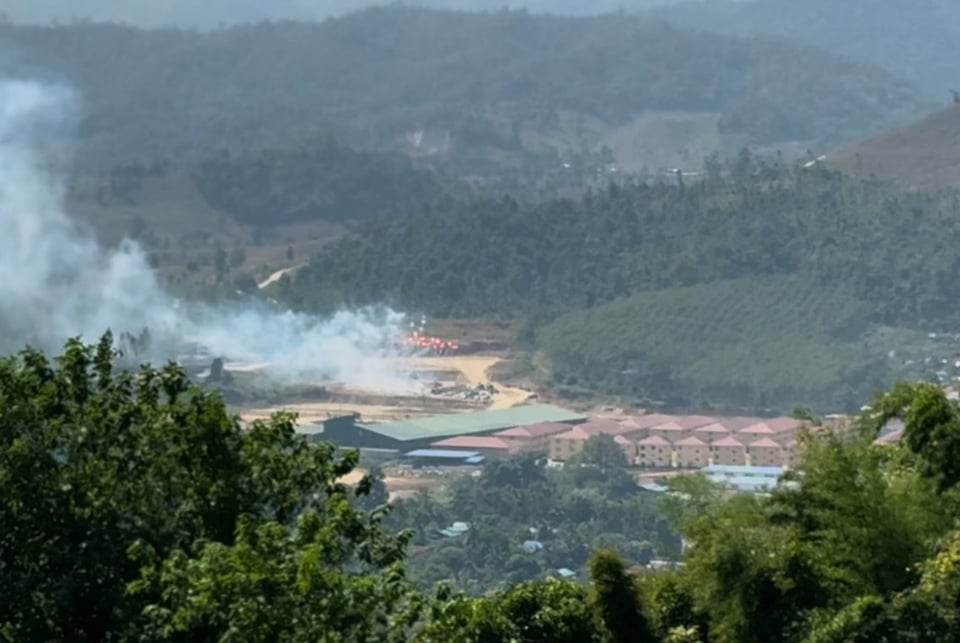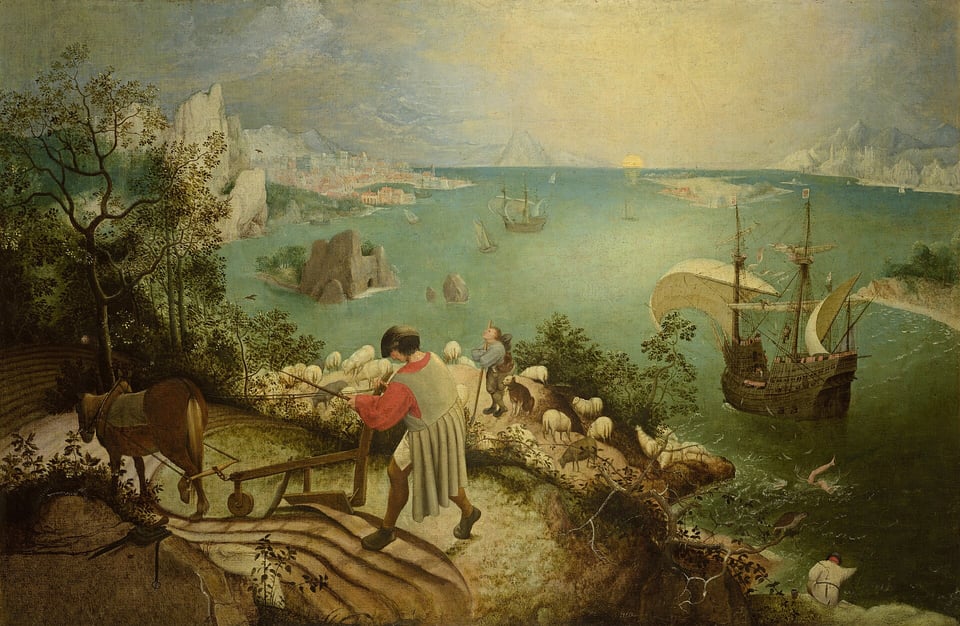The Moei River: A Modern Remake of Bruegel's Icarus
Reflections on an eye-opening journey along the Thai-Myanmar border where, at least for now, crime does pay.
On a recent Sunday morning, I stood on a hill overlooking a winding river along the Thai-Myanmar border. The setting was like something out of a landscape painting, with farmlands and forests dotting the Thai side of the Moei River. Along one bend in the Moei, a farmer took advantage of the cooler mid-morning weather to till his fields before the afternoon heat set in. As he crossed his fields barefoot, a fortress-like compound looked on menacingly from the other side of the river. The encampment featured barred windows and dormitory-like buildings arranged beside a dock for barges to bring people and goods in and out. Cell towers peppered the horizon behind the sprawling complex.

The jarring contrast with the idyllic setting on his side of the Moei must have prompted the farmer wonder at some point, “what’s going on inside all those buildings that have sprung up along the river?” I was fortunate to join a group of experts on my November trip who have spent years examining that question. The troubling answer – these buildings house industrial-scale scamming operations that are often staffed with victims of human smuggling forced to perpetrate online fraud – immediately makes you wonder how it is that such places are allowed to exist, let alone to thrive and expand. As we drove along the river, I realized that the pastoral landscapes around us provided the perfect metaphor to explain the forces that allow this illicit industry to flourish.
The old adage that underpins the criminal justice system – crime doesn’t pay – doesn’t apply. Here, crime does pay, to the tune of tens of billions of dollars a year. One recent report by a group of experts convened by the United States Institute of Peace estimated that cybercriminal syndicates based in the Mekong region of Southeast Asia likely clear more than $43.8 billion a year in illicit profits. That equates to over 40% of the combined formal GDP of Laos, Cambodia, and Myanmar, the three countries at the epicenter of the crisis. Three co-authors of the report accompanied our expedition, including Erin West, the founder of a new cross-industry coalition seeking to upend these scam centers’ ability to ply their trade with impunity.

That impunity was on full display when our group arrived on a hill overlooking a sprawled-out embankment of buildings called Tai Chang. Over the past year, this fraud camp has become notorious for some of the worst stories of human rights abuses emanating out of Southeast Asia’s scam fortresses. As we exited our cars, we saw fireworks going off near a stage whose lettering said, “groundbreaking ceremony.” A throng of vehicles and heavy equipment stood nearby for the ceremony, which seemed to mark the beginning of new construction at the site. Following the fireworks, Judah Tana, the founder of Global Advance Projects, a local charity that helps rescue human trafficking victims from Tai Chang and other scam compounds along the Moei, detailed some of the torture that goes on inside when forced laborers refuse orders or try to escape; I won’t repeat it here, but suffice it to say that by the end of this reporting trip, I was disturbed enough that I needed someone to talk to.
The contrast of immense human suffering and celebratory fireworks reminded me of a poem written on the eve of World War II which illuminates why these scam centers are able to operate. In 1938, a young British poet visited an art museum in Belgium and wrote a timeless poem about human suffering. W.H. Auden marveled at a painting of a boy drowning in the Aegean Sea as everyone around him turned away instead of helping him; he observed that “everything turns away quite leisurely from the disaster” – from the nearby ploughman who heard the splash to a ship that saw his legs flailing in the water but sailed calmly on. The drowning boy was Icarus, who flew too close to the sun and fell to his death when his wings of wax melted, and the painting by Pieter Bruegel the Elder elegantly captured this famous moment in Greek mythology that tells us so much about human nature (scroll through this beautiful explanation of Auden’s poem in the New York Times and you’ll realize why it’s so timeless).

Erin and I saw several modern renditions of Bruegel’s painting along the Moei River when we spotted farmers tilling their fields within view of massive scam compounds on the Myanmar side of the river. They turned away, as Auden might put it, quite leisurely from the disaster unfolding across the river. And it is exactly that contrast of everyone going about their business in the face of human suffering that enables this industry to flourish. From corrupt government officials to social media platforms and various cryptocurrency firms, Southeast Asia’s burgeoning scam industry has had no shortage of enablers who looked the other way as these fraud gangs perfected their tactics and expanded their empires. Like the farmers who till their fields while someone on other side of the river is getting tortured, they too turned away from the disaster, even though they were much better placed to do something about it.
Erin and I were both jarred by this pastoral contrast. As we discussed it, we saw cement trucks rumbling past us to the river’s edge to hop on a barge and cross the Moei. Another major scam compound was also expanding – and it needed cement. The cement was not in short supply, nor the internet, electricity, nor anything else, as far as we could tell, that these compounds need to operate. For every demand, there was supply, and every supplier could turn their back on the humanitarian crisis and go about their business, enabling Tai Chang and its peers to do the same. Hence the fireworks; they were as much a celebration of the normalization of the illicit activity along the Moei as they were a fete to any physical expansion.
Auden’s poem proved prescient; barely a year after it was written, the world was engulfed in a massive conflict and witnessed untold suffering. It is not too late for the world to stem the tide of human suffering emanating from Southeast Asia’s fraud factories. But it will require different approaches and cross-border collaborations by public and private sectors to make sure that here, too, crime doesn’t pay.
I hope to explore some of those solutions in The Big Trace. Thanks for joining me on this journey, and thank you to Erin and our other trip participants and guides for such an eye-opening expedition.